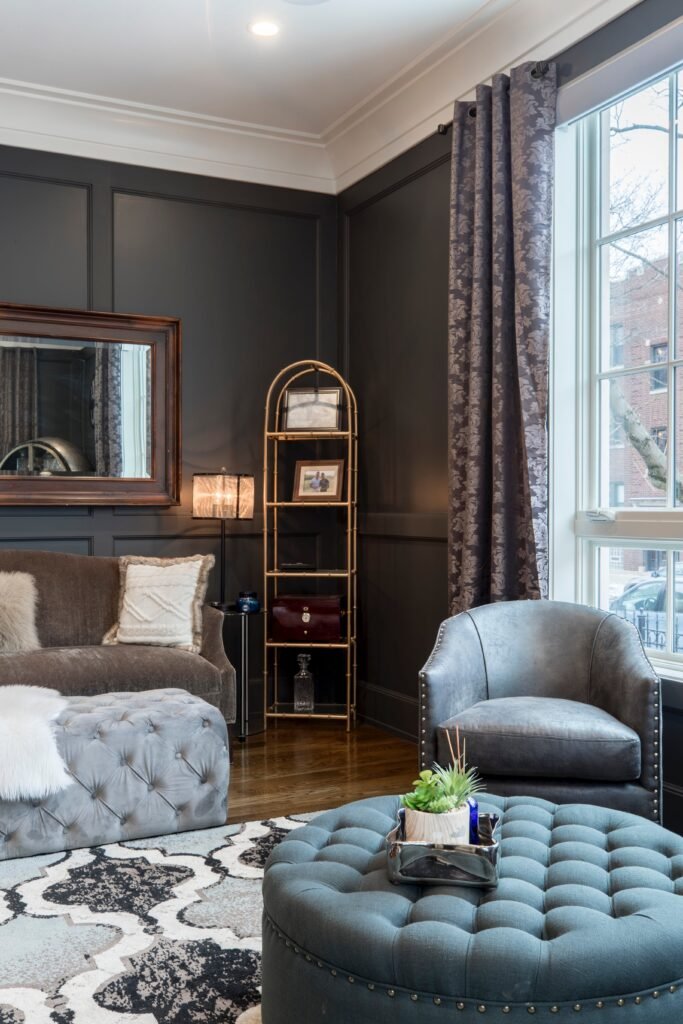Pattern and Texture in Home Staging & Interior Design:
Combining various patterns and texturesMateriality in Home Staging & Interior Design: The selection and combination of materials used in a space, like wood, metal, glass, fabric, and stone. In staging and design, it influences the overall aesthetic, texture, and tactile experience, impacting the mood and functionality of the space. T... More in fabrics, furniture, rugs, and wall coverings to add visual interest"Focal Point" in Home Staging & Interior Design: A visual element that draws attention and sets the tone for a space, like a fireplace, artwork, or architectural feature. Effective staging uses focal points strategically. The Importance of Focal Point in Home Staging - Why It's Something to Cons... More, depth, and personalityStyle in Home Staging & Interior Design: The overall aesthetic or design language chosen for a space, influencing furniture selection, décor, color palette, and textures. The Importance of Style in Home Staging - Why it's Something to Consider The Style chosen in home staging sets the overall t... More to a space. In staging, using patterns and textures strategically creates a layered and inviting atmosphere.

The Importance of Pattern and Texture in Home Staging – Why it’s Something to Consider
Pattern and Texture are crucial elements in home staging as they add depth, interest, and dimension to a space. Patterns can enliven a room, whether through wallpaper, textiles, or artwork, while textures can evoke a sense of comfort"Ergonomics" in Home Staging & Interior Design: Designing spaces for comfort, safety, and efficiency, considering furniture placement, traffic flow, and accessibility for different users. The Importance of Ergonomics in Home Staging - Why It's Something to Consider Ergonomics is an important con... More and warmth. In staging, using a mix of patterns and textures can create a more layered and inviting environment, which is key in helping potential buyers envision themselves living in the home.
When incorporating pattern and texture, it’s important to balanceVisual Weight in Home Staging & Interior Design: The perceived heaviness or lightness of objects and elements within a space, influencing balance and visual interest. The Importance of Visual Weight in Home Staging - Why it's Something to Consider Visual Weight in home staging refers to the perc... More them so as not to overwhelm the space. The use of patterns should complement the overall color scheme and style"Accessorizing" in Home Staging & Interior Design: The act of adding decorative elements to a space, like placing throw pillows on a sofa or arranging books on a coffee table, to complete the look and inject personality. The Importance of Accessorizing In Home Staging - Why It's Something to Con... More of the room, while textures can range from soft fabrics to rougher natural elements"Biophilic Design" in Home Staging & Interior Design: Incorporating natural elements like plants, natural materials, light, and ventilation into a space to create a connection with nature, promoting well-being and reducing stress. The Importance of Biophilic Design In Home Staging - Why It's Som... More, depending on the desired ambiance. Skillful use of these elements can significantly enhance the visual appeal"Appeal" in Home Staging & Interior Design: The overall attractiveness and desirability of a property to potential buyers, influenced by factors like curb appeal, layout, functionality, and staging. The Importance of Appeal In Home Staging - Why It's Something to Consider Appeal, in the context ... More of a property, making it more attractive to buyers.
Tips and Best Practices when Utilizing Pattern and Texture in Home Staging
Incorporating Pattern and Texture, involving visual layersTexture in Home Staging & Interior Design: The surface quality of materials used in a space, adding visual interest and tactile elements. The Importance of Texture in Home Staging - Why it's Something to Consider Texture adds depth and interest to a space, making it an important element in home ... More and sensory experiences, can add depth and interest to staging. Best practices include:
Balanced Use of Patterns: Incorporate patterns in a balanced way, using them for accent pieces"Accent Pieces" in Home Staging & Interior Design: A striking or unique item that draws attention and becomes a focal point in a room, enhancing the overall design and setting the tone. The Importance of Accent Pieces In Home Staging - Why It's Something to Consider Accent Pieces, including stat... More like pillows, rugs, or artwork.
Mix Textures Thoughtfully: Combine various textures, such as smooth and rough, to create depth without overwhelming the space.
Complement Room’s Style: Ensure that patterns and textures complement the room’s overall style and color palette"Color Palettes" in Home Staging & Interior Design: The range of colors chosen for a space, including walls, furniture, fabrics, and décor, setting the overall mood and influencing the perception of size, light, and warmth. The Importance of a Color Palette In Home Staging - Why It's Something ... More.
Visual InterestLayering in Home Staging & Interior Design: Combining various elements like textures, patterns, and colors in a space to add depth, visual interest, and a sense of coziness. Layering is a key technique in creating inviting and stylish spaces. The Importance of Layering in Home Staging - Why it's... More: Use patterns and textures to create focal points and visual interest in a room.
HarmonySymmetry and Balance in Home Staging & Interior Design: Creating a sense of order and visual harmony in a space through balanced furniture placement and repetition of design elements. The Importance of Symmetry and Balance in Home Staging - Why it's Something to Consider Symmetry and Balance are... More and Cohesion: While mixing patterns and textures, maintain a sense of harmony and cohesion in the overall design.

